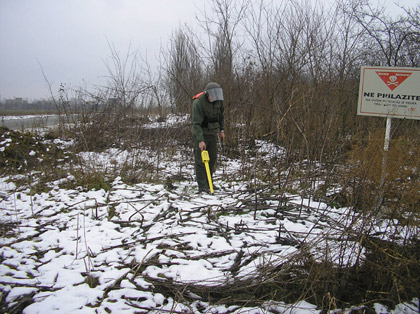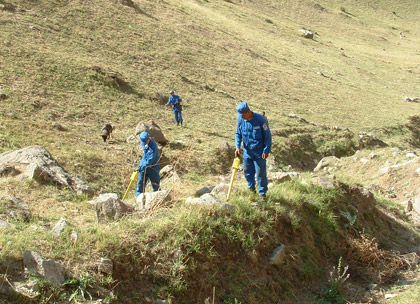One Company’s Humanitarian Demining Program
Landmines, unexploded submunitions and explosive remnants of war (ERW) all pose a serious and ongoing threat to civilians. During and after conflicts, these weapons can be found on roads, footpaths, farmers’ fields, forests, deserts, along borders, in and surrounding houses and schools, and in other places where people carry out their daily activities. They can deny access to food, water and other basic needs, and inhibit freedom of movement, thus limiting people’s ability to participate in education or access medical care. Mine and ERW contamination may also prevent the repatriation of refugees and internally displaced people, as well as hampering the delivery of humanitarian aid. (Source: Landmine and Cluster Munition Monitor: www.the-monitor.org)
While response is ongoing on the part of the United Nations (UN), world governments and non-governmental organizations (NGOs), a role also exists for the private sector – companies, groups and individuals. Awareness of the issue, along with an impetus to respond, can provide ordinary citizens the opportunity to extend the reach of the major institutions and enable solutions where they would not otherwise be possible. This ideology was the impetus for a socially responsible business development idea for West Virginia’s Schonstedt Instrument Company, a 55-year-old manufacturer of handheld devices that find buried ferrous metals.
Schonstedt had been making magnetic locators for most of its history, mainly for surveyors needing to find property boundary markers that had worked their way into the earth or were otherwise hidden from view. Forty years ago Erick Schonstedt, the company’s founder and renowned magnetics scientist, was asked by a neighbor if he could help him find his lot’s corner markers. Until then, Schonstedt had worked with the Office of Naval Research to identify the magnetic signature of submerged submarines during World War II and with NASA to provide magnetometers for the aerospace industry. His patented HeliFlux® magnetic sensor technology became part of the navigation systems of more than 400 satellites, including the Hubble telescope.
Today, and largely due to the neighbor’s question, the company has transitioned from a government contracting, scientifically oriented “job shop” to a fully commercial producer of tools that find any number of underground objects, among them, metals. Although the metal detectors most people are familiar with find all types of metal – iron, steel, gold, silver, aluminum, brass – a magnetic locator finds only ferrous metals and at significantly greater depths than their “all-metal” counterparts.

Photo Courtesy of the Croatian Mine Action Centre (CROMAC) | Mine clearance along a power line in Eastern Croatia.
This is because magnetic locators, known as magnetometers or gradiometers, work on the principle that ferrous metals cause a disruption in the earth’s magnetic field. That anomaly can be detected, measured and communicated to a user. This makes the ferrous metal locator especially useful in finding applications that municipal utilities, mainly city and town water departments, would be interested in.
Neither surveyors nor municipalities represented high-growth markets in 2006, so Schonstedt went in search of other opportunities and noticed the uptick in sales from magnetic locators used to find unexploded, explosive ordnance (UXO). The latter includes bombs, mortar rounds, rockets, grenades, ammunition and other buried munitions – all ferrous metal objects. The U.S. Army was using them to find and remove UXO in Iraq and Afghanistan while private sector “munitions response” contractors were using them to clear ranges at active U.S. military installations and perform base clean-up at formerly used defense sites (FUDS). In addition, NGOs were purchasing them for remediation contracts internationally. This led Schonstedt to an awareness of a whole new market possibility – humanitarian demining.
Humanitarian demining operations take place after a conflict. However, instead of supporting military operations, these efforts allow displaced people to return to their homes and villages, to tend to their fields and to send their children to school without fear of being maimed or killed by hidden bombs, landmines and other explosive remnants of war. It was an enormous opportunity, except those parts of the world that suffer most from the ravages of war are in no position to afford demining costs. That led Schonstedt to ask how it could help because rather than a garden-variety market opportunity, this life-saving project presented a chance to do some real good in the world. The challenge was to design a program that would be sustainable throughout the long-term and not merely exist as a one-time response to an ongoing need.
Could Schonstedt tie the donation of a magnetic locator to the sale of a pipe and cable locator, which locates underground utilities, such as water and gas lines, electrical cables, telephone, cable TV and fiber optic lines? Such a program would accomplish the humanitarian demining objective and ensure an ongoing supply of demining tools. Some financial analysis determined the feasibility and the outline of a program emerged. Next, Schonstedt would need help understanding and prioritizing the global need for its tools, as well as placing them into the hands of trained deminers in the most underserved countries. The company reached out to the United Nations, who agreed to help and, in January 2007, the Schonstedt Humanitarian Demining Initiative was born. The agreed-upon arrangement was to provide an ongoing supply of free equipment for humanitarian demining where it was needed most and would not otherwise be possible without a contribution of this sort.
The initial program was later modified as a result of an inquiry at the American Congress on Surveying and Mapping when Frank Lenik, a surveyor, noticed a poster with the slogan, “Buy a Schonstedt; Save a Life.” Lenik had no need for a pipe and cable locator but, having served in the Peace Corps in Sierra Leone, was aware of the landmine issue and wanted to help by simply buying a magnetic locator and donating it. Schonstedt subsequently modified the program to include a second locator at no charge with any purchased for donation. Meanwhile Lenik, a Quaker, went back to his congregation to talk about his discovery. In short order, its members had raised enough funds to provide three of the 10 units now at work in Tajikistan.

hoto Courtesy of Tajikistan Mine Action Centre | UN deminers, working their way up the mountains, search for buried cluster bombs in Tajikistan.
Originally scheduled to go elsewhere, these units were diverted to Tajikistan at the urgent request of the United Nations. The spring snow melt had caused cluster bombs, dropped during that country’s civil war, to work their way to the surface in the mountains and gullies overlooking a small town. It was feared that local residents, cutting mountain grasses for winter fodder, could easily disturb and detonate the explosives. Until the arrival of these units, the bomblets could be cleared only when seen by the naked eye. While 10 submunitions had been found visually in one gully, the arrival of the locators revealed an additional 17 hidden beneath the surface.
Lenik’s efforts caught the attention of The Philadelphia Inquirer, which ran a feature in a Saturday issue and by the following Monday a stream of donations to the Woodstown Monthly Meeting began that would last for weeks. Within the first month, USD$10,000 had been raised, and the church donated an additional USD$2000, which enabled the purchase of 12 units. Schonstedt matched the 12 purchased units with 12 donated units and 24 locators were shipped to UN-supported humanitarian deminers in Vietnam.
Quaker meetings from throughout the United States, and as far away as Australia, began raising funds, as did other church groups, often as a youth group activity. Lenik, a long-time surveyor licensed in several states, was invited to talk about the program at various state society chapter meetings, resulting in broad support from the surveyor community. As word filtered out more individuals became involved, as did school groups, student surveyor chapters and small businesses.
Much of the program’s appeal to donors lies in the absence of middlemen and administrative overhead. The Woodstown Friends Meeting functions as a no-cost intermediary for individual contributions, which it consolidates and forwards to Schonstedt. Schonstedt then coordinates with the UN to identify recipients, who are asked to pay shipping costs. With a destination address and wired funds, Schonstedt ships the donated equipment in batches of up to 30 directly to deminers on the ground, where they are put to work immediately. To date, the countries and numbers of units deployed include: Tajikistan – 10, Kenya & Somalia – 20, Laos – 20, Vietnam – 24, Nepal – 30, Egypt – 25, Croatia – 8, Serbia – 4, Macedonia – 4, Kosovo – 4, Bosnia/Herzegovina – 4, Montenegro – 4, Mauritania – 30, Chad – 30. Ethiopia – 30, Sudan (Darfur) – 30, Azerbaijan – 20, Cambodia – 20, Algeria – 35, Gaza – 5, Libya – 36 and Lebanon – 2.
This totals 395 units at work in 23 countries. Additionally, five of the tools have been shipped to a rapid response inventory at UN Headquarters in New York for deployment to countries without a national authority to request them, as was the case recently in Libya. Another 30 units have become part of emergency stand-by kits at the International Committee of the Red Cross (ICRC) in Geneva. Recent examples of ICRC need include ammunition stockpile explosions in Abijan, Cote d’Ivoire and Brazzaville, Democratic Republic of the Congo. Schonstedt has partnered with the U.S. Department of State, which complements the UN in terms of providing needs assessments, and is in discussions with the Organization of American States about providing instruments to some of its 27-member nations.
Because of the ongoing, unmet demand for humanitarian demining throughout the world, which is expected to last for decades, Schonstedt’s current focus is on broadening the donor base to include more “institutional” contributions. The company is reaching out to corporate responsibility (CR) officers at several major organizations in the hope that one or more may consider incorporating the program into its CR portfolio and/or offering its employees the opportunity to contribute individually.
Below are excerpts from comments made by some of the demining field organizations:
The Schonstedt Humanitarian Demining Initiative represents an open-ended commitment by Schonstedt and its donors to humanitarian demining where it is most urgently needed in the world – and where it would not otherwise be possible.




























